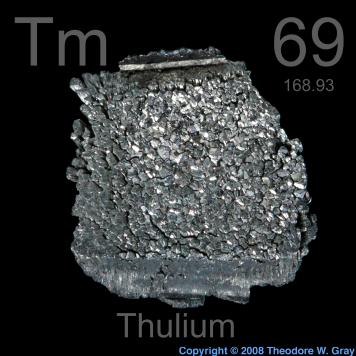Thulium is a chemical element belonging to the lanthanide series of rare-earth metals. It is the 13th element and the third to the last in the series. The element has the atomic number 69 and is known by the symbol, Tm. Thulium has variable oxidation states, but the most common oxidation state is +3, which is similar to that of other lanthanides. The +3 oxidation state is the most commonly seen in its oxide, halides, and other compounds. Studies have also shown that the +2 oxidation state can also be stable.
Furthermore, soluble thulium compounds form coordination complexes with nine water molecules. Like the other lanthanides, thulium also has its unique application. Thulium is mainly used in producing additives used for making neodymium iron boron alloys, giant magnetostrictive materials, magneto-optical storage materials, and non-ferrous metal alloy casting. Thallium is pretty rare and has no significant biological role. Neither is it particularly toxic.
Discovery of Rare-Earth Element Thulium
Thulium is primarily found in yttrium silicate, yttrium phosphate and rare black gold ore. Unlike some other lanthanides, thulium is quite rare and expensive. In 1879, the Swedish chemist Per Teodor Cleve separated two previously unknown materials from the rare-earth oxide erbia. He named these components holmia and thulia. They turned out to be the oxides of holmium and thulium, respectively. Per Teodor Cleve was able to separate thulium by looking for impurities in the oxides of other rare-earth elements, a method earlier used by the Swedish chemist, Carl Gustaf Mosander in discovering other rare-earth elements, such as yttrium and terbium.

In 1911, a relatively pure sample of thulium metal was obtained by Charles James, a British expatriate, who was conducting research at New Hampshire College in Durham, the USA at the time. He used bromate fractional crystallization to achieve the purification of Thulium. It was not until the late 1950s that high-purity thulium oxide was first offered commercially, owing to the huge success of the newly-adopted ion-exchange separation technology.
Occurrence of Rare-Earth Element Thulium
Thulium is the second-least abundant of the lanthanides, after radioactively unstable promethium, which is only found in small quantities in the earth’s crust. The metal is malleable and characterized by a bright silvery-gray luster. It is fairly soft and slowly tarnishes in the air. Despite its high price and scarceness, thulium is used as the radiation source in portable X-ray devices, and in certain solid-state lasers.

Thulium has never been found in its pure form in nature. Instead, it is found in small quantities in minerals with other rare-earth elements. The element is mostly found with minerals containing yttrium and gadolinium. In particular, thulium occurs in the mineral gadolinite, even though it also occurs in the minerals monazite, xenotime, and euxenite, similar to several other lanthanides. It is most abundant in China. However, large reserves of the element are also available in Australia, Brazil, Greenland, India, Tanzania, and the United States, with the total reserves of thulium on earth coming up to approximately 100,000 tonnes. Commercially, thulium is primarily obtained from monazite ores, which are found in river sands, but using the ion-exchange separation technique.
Isotopes of Rare-Earth Element Thulium
Thulium has several isotopes ranging from 145Tm to 179Tm. There are 35 isotopes and 26 nuclear isomers of thulium that have been detected. The most abundant stable isotope is 169Tm, with the primary decay mode before it being electron capture, and the primary mode after it is beta emission.
Thulium-169 is the only primordial and stable isotope of thulium. The isotope is predicted to undergo alpha decay to holmium-165 with a very long half-life. The radioactive isotopes with the longest lives are thulium-171 (half-life of 1.92 years) and thulium-170 (half-life of 128.6 days). Most of the others have half-lives of a few minutes or less.
Properties of Rare-Earth Element Thulium
- The element has a silvery-white color.
- It is malleable and ductile, soft, and can be cut with a knife.
- Thulium has a Mohs hardness of 2 to 3.
- It exhibits ferromagnetic properties below -402.07 °F; it is antiferromagnetic between -402.07 and -358.9°F, and paramagnetic above -358.9°F.
- There are two major allotropes of thulium: the tetragonal α-Tm and the more stable hexagonal β-Tm.
- The metal is quite electropositive and reacts slowly with cold water and quickly with hot water, forming thulium hydroxide.
- It tarnishes slowly in the air and burns readily at a temperature of 150 °C to yield thulium(III) oxide.
- Thulium reacts slowly with halogens at room temperature but vigorously at temperatures above 200 °C.
- It also combines with different metallic and non-metallic elements to form a range of binary compounds, such as TmN, TmS, TmC2, Tm2C3, TmH2, TmH3, TmSi2, etc.
Uses of Rare-Earth Element Thulium
Thulium has fewer commercial applications compared to other rare earth. This is major because of its rarity and high cost.
- Thulium is used in portable X-ray devices, where it has been widely used as a radiation source in nuclear reactions.
- Thulium sputtering targets and thulium evaporation materials are used in deposition processes including semiconductor deposition, chemical vapor deposition (CVD), and physical vapor deposition (PVD).
- Thulium has also been used in high-temperature superconductors just like yttrium.
- Combined with holmium and chromium as holmium-chromium-thulium triple-doped yttrium aluminum garnet, it can be used as an active laser medium material with high efficiency.
- Due to its fluorescence with a blue color when exposed to ultraviolet light, thulium is added to euro banknotes as a measure against counterfeiting.
Thulium has potential application in ferrites and ceramic magnetic materials used in microwave equipment.
Conclusion
Thulium is a rare-earth metal belonging to the lanthanide series, with a silvery-gray coloration and found in the earth’s crust. It has an atomic number of 69 and is denoted by the symbol, Tm. If you want to know more about rare earth coating materials, we would like to advise you to visit Stanford Advanced Materials (SAM) for more information.





